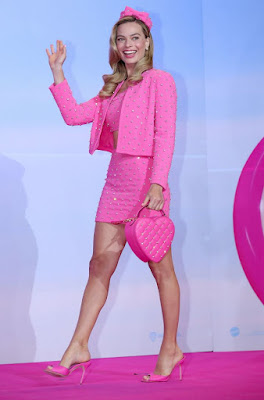The Controversial History
By Marie Lodi, CNN
Published 6:34 PM EDT, Tue July 18, 2023
When the trailer for Greta Gerwig’s “Barbie” movie was first released, Google Trend searches for fluffy mules shot up 115 percent. This was, of course, largely inspired by the trailer’s scene featuring Margot Robbie’s Barbie stepping out of her pink stilettos and into a tip-toe pose, a reference to the doll’s signature stance due to her perpetually frozen feet. (In 2015, Mattel began making Barbie dolls with adjustable ankles so she could finally relax — and wear flats.)
With a wardrobe now spanning 64 years worth of fashion, she’s had her pick of footwear, but Barbie has been closely associated with the stiletto mule — also called the stiletto slide or sandal — since her inception.
 |
| At an event in Seoul, South Korea on July 3, Robbie wore hot pink Moschino separates |
Matrix.”
And throughout the film’s meticulously thought-out press tour, Robbie has been knocking out look after Barbie-themed look, with designer pieces frequently paired with high-heeled mules custom designed by Manolo Blahnik — like a take on the 1964 “Sparkling Pink” Barbie, for example, which Robbie replicated for a press conference in Seoul, South Korea.
“When you walk in mules, you walk a bit differently…Madame de Pompadour in her mules, walking around Versailles, click click click,” Blahnik once quipped. “Can you think of anything more exquisite?”
Mattel co-founder Ruth Handler introduced Barbie to the world in 1959, changing everything the world then knew about girls’ dolls. The doll’s inspiration was somewhat controversial, coming in part from the German comic strip character Bild Lilli, a sassy high-end call girl who was later sold as an adult novelty doll. A model in many respects, Barbie had breasts and an anatomically impossible figure, and wore a fashion-forward look created by Mattel designer Charlotte Johnson: a black and white striped bathing suit paired with backless heels.
 |
| Neiman Marcus - Christian Louboutin Me Dolly Patent Red Sole Sandals $795 - Sold Out |
“Our mules are still used on Barbie,” Mattel’s Kim Culmone, SVP of Barbie Design, told CNN. “Less so on dolls targeted to kids because they fall off and lose them — we do keep playability in mind, but the open toe backless shoe style is used on collector dolls and in reproductions.”
The mule has both a storied and complex history, and has “for centuries been connected to ideas of play, private time, and intimacy,” said Semmelhack. According to Semmelhack, backless slippers first became more ornately designed for upper-class women in the 1600s. In the 18th century during the Rococo period, culture in Europe grew more focused on more intimate gatherings, so the mule functioned similar to the way a house slipper would. (A pair of silk mules belonging to Marie Antoinette sold for $57,000 in 2012.) “These elements of dress that had previously been worn, just in the privacy of one’s boudoir, start to become a little more appropriate, not for fully formal occasions, but for a wider range of them,” she said, adding that “they basically signaled that you were a little more relaxed.”
The heeled mule came back into women’s fashion in the middle of the 19th century, as part of a wave of nostalgia for 18th century style. “At that point, they still continued to signify the kind of private domestic realm,” Semmelhack continued, “so the backless mule was kind of equivalent to being in a state of undress.”
Erotic photography came about in the 19th century, and Semmelhack points to depictions of women wearing nothing but heels, which increased the hypersexualization of the high heel in the following decades. (In Edouard Manet’s famous 1863 oil painting “Olympia,” for example, a woman lies on a bed, wearing nothing but yellow mules.) “You add in the peep toe, which came in in the 1930s, then fast forward to the post-war period of the 1950s, and you’re starting to see the back of the foot and the toes of the feet,” she explained. “It also gets interpreted as a boudoir slipper, and the quintessential Frederick’s of Hollywood shoe. By the 1950s, the height of a heel begins to skate towards the tawdry.”
In other words, just like “Barbie” is a film about a doll breaking out of her box, it’s time to break a pair of mules out of theirs.



No comments:
Post a Comment